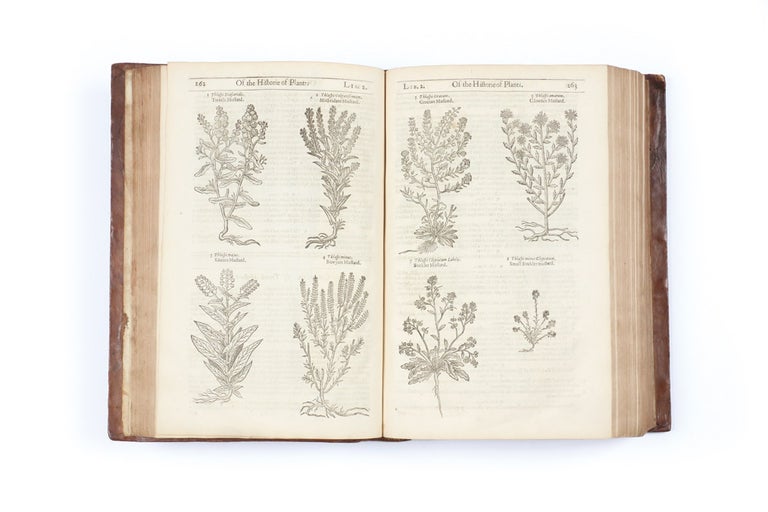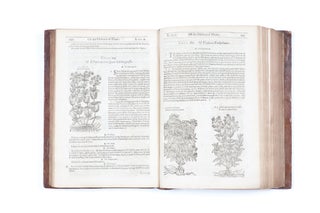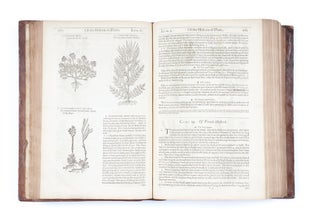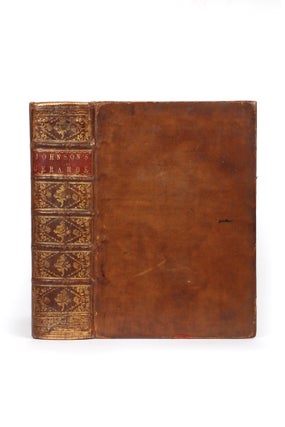The Herball, or Generall Historie of Plantes.
London: Adam Islip, Joice Norton, and Richard Whitakers, 1636.
Thick folio, with more than 2500 woodcut illustrations of plants, as well as numerous other woodcut decorations; contemporary sprinkled calf, spine ornately gilt in wide compartments, red morocco label.
With more than 2500 botanical woodcuts
A splendid copy of one of the most famous English herbals, here in the second printing of the best edition, Johnson's 'very much enlarged and amended' version which first appeared in 1633. This massive herbal made the barber-surgeon and horticulturist Gerard (1545-1612) famous when its first version appeared in 1597, and it remained highly esteemed for more than 200 years. Gerard's work was based on his experience in his own substantial gardens and as superintendent of several others in and around London, including various properties owned by William Cecil, first Baron Burghley, whose gardens were famous for their variety of plants and trees.
A splendid copy of one of the most famous English herbals, here in the second printing of the best edition, Johnson's 'very much enlarged and amended' version which first appeared in 1633. This massive herbal made the barber-surgeon and horticulturist Gerard (1545-1612) famous when its first version appeared in 1597, and it remained highly esteemed for more than 200 years. Gerard's work was based on his experience in his own substantial gardens and as superintendent of several others in and around London, including various properties owned by William Cecil, first Baron Burghley, whose gardens were famous for their variety of plants and trees.
Despite claims that his work was derivative, 'Gerard contributed greatly towards the advancement of the knowledge of plants in England, and in his Herball described and illustrated several hundreds of… native plants, including about 182 which were additional to those recorded in earlier works…' (Henrey). In 1632 the successors of Gerard's first publisher commissioned Thomas Johnson (d. 1644), the well-known apothecary and botanist, to prepare a second edition. He did this so well and added so much (a valuable comprehensive historical introduction as well as half again as many woodcuts) that Johnson's version is generally recognised as the "best edition". Johnson 'corrected many of Gerard's more gullible errors, and improved the accuracy of the illustrations by using Plantin's woodcuts…' (Hunt). Arber says that 'the Herball, thus transformed, reached a far higher level than Gerard's own edition'. In this revised form, the book was still being used in botany classes as late as the end of the 18th century. The thousands of charming woodcuts are both large and detailed, and represent an incredible body of work.
"The title-page of The Herball is particularly attractive. It was executed by John Payne (1607-1647), one of the most talented engravers of the period… In the upper part of Payne's work we see a luxuriant garden with the goddesses Ceres and Pomona on either side. Below them are the fathers of botany, Theophrastus and Dioscorides, while in the lower section two imposing vases filled with flowers surround a portrait of Gerard, who is shown facing in the opposite direction to that of the portrait by Rogers. The vase on the left is crowned with a bunch of bananas as a tribute to Johnson…
"One of the most significant additions made by Johnson was his chapter on the 'Maracot' or 'Grandilla' as it was called at the time (actually the passion-flower). He includes a full page illustration (p. 1592) and refers the reader to Monardes for more information on this exotic species… In the long preface Johnson traces the history of the botanical sciences, analyzing the contributions of celebrated figures from the mythical King Solomon to William Turner… He closes with some critical remarks on John Gerard and the origins of his herbal." (Tomasi & Willis, An Oak Spring Herbaria, p. 84).
Provenance: Armorial bookplate of "Walford" and 17th-century signature of Elizabeth Taylor of Wimbish Hall (Essex).
Henrey, 156; Hunt, 230; Nissen, 698; Pritzel, 3282; STC, 11752.
Condition Report: The engraved title page mounted, with tiny losses at corners and inner margin, dedication leaf slightly soiled and stained, a few minor spots and stains; binding neatly repaired at joints and extremities; in overall excellent condition.
Price (AUD): $13,500.00
US$8,816.33 Other currencies





